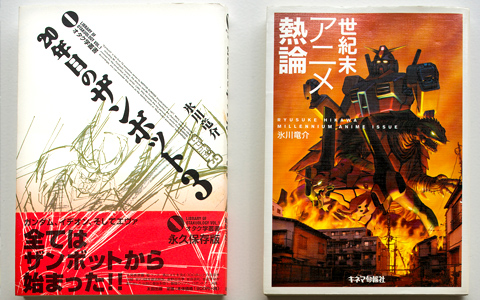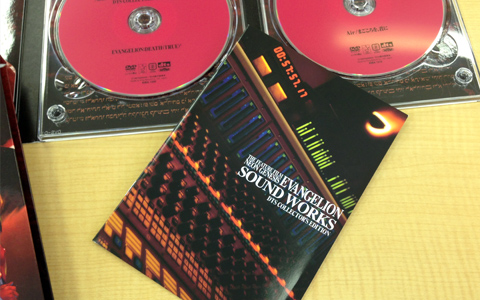In the Beginning, I Hoped I Could Be Helpful
“I’m looking for the answer as to why we love anime.”
This is a sentence from the preface of Seikimatsu Anime Netsuron, a book Hikawa published in 2000. This book is the summary of the reviews he contributed to magazines in the second half of the ‘90s and also a masterpiece that accurately discusses the the change of hit anime from the ‘70s to Eva and the “way of watching” them. Hikawa have been continuing to put into words seriously what exactly in anime moves the hearts of the audience with exceptional analytical abilities and a calm, observant eye. The way Hikawa writes is filled with pure, warm emotion toward animation itself that would surely resonate even with fans who aren’t that well-versed in anime. The anime in question, Neon Genesis Evangelion, was a piece of work that emitted a similar energy from the screen.
“I first met Anno at a drinking party around ‘80 where we sat by each other. We first talked about Evangelion during the production of the movie DVD (DTS version) released in ‘04. In the same year, I was also involved in director Katsuhiro Otomo’s movie, Steamboy, and as the sounds would be recorded in Hollywood, I went to America to collect materials. I’m particular about sounds, since I originally used to work in record production. This experience paid off as King Records came to me with a proposal. When renewing the DVD of the Eva movie into DTS, Anno asked me to interview the staff and him about their feelings toward ‘sound’, focusing on the work of making the 5.1-channel version.”
That was the first time Hikawa did official work on Evangelion, a dense interview in the booklet packed with the DTS version of the DVD.
“I did the interviews in a bar in Shibuya. I went in when the bar opened at 5 p.m., and we kept talking until closing at 11 (laughs). This was my longest interview at the time, and the subject reached as far as the tokusatsu works that became formative experiences for Anno. It was a little while after that that the production of the new movie came up as a subject. Although the number of late night anime rose with the spreading of DVDs, not many original new works and hit anime came out after Evangelion. Didn’t that make Anno, who himself distanced himself from anime for a while, feel an even stronger sense of danger? At this point, he said something like, if doing an Eva remake would become a supporting foundation for anime culture, then…[he’d do it.] So I told him how I felt, with the nuance that I wanted to help If there was anything I could do.
And when he said that, Hikawa’s feelings of wanting to help were genuine.
“Why? Because I thought that if the potency of the people talking about Evangelion in the ‘90s was 100%, I’m just a superficial fan of about only 5-7%. That’s how amazing hardcore fans are. I’m still at the level that I feel surprise and admiration when reading the theorizing of fans (laughs)”
Production of a new movie was announced in 2006, a year before 1.0 was released. Director Anno, who broke away from Gainax, the studio he was affiliated with, and established the production studio named Khara, announced it himself. It was the ominous message that was also featured in the movie pamphlets of 1.0, beginning with the phrase, “What are we trying to redo?”
“That statement was a shock, and I clearly felt his intent to make a new movie.
I was especially captured by the part in the beginning that goes, ‘animation offers the embodiment, the diversity of expressions, and the true interestingness that touches our primary emotions.’ A strong will to rise to the challenge of answering the question “What is the origin of the emotions animation brings out in people?” is what spurred me on. I had a hunch that I might find something I was missing from the discourses regarding the Eva boom of the ‘90s, that I might get closer to answering the questions I have always pursued: What makes animation interesting? What is it capable of?”

Left: 20-nenme no Zambot 3 (Ohta Books), Hikawa’s first book in which he pursues the source of real robot anime in Invincible Super Man Zambot 3, an anime made by director Yoshiyuki Tomino two years prior to Gundam. It also contains detailed explanations about legendary animators such as Yoshikazu Yasuhiko and Yoshinori Kanada.
Right: Shin Seiki Anime Netsuron, published in 2000 by Kinema-Junpo Co., Ltd., looks back on the hit anime of the ’70-90s, also touching the subjects of tokusatsu and the goods around.

The high sound quality DVD that recorded the sounds of the old movie in DTS titled “Feature Films Neon Genesis Evangelion DTS Collectors Edition” (released in 2004). The attached booklet sheds light on the staff’s respective fixations regarding sound, from director Anno himself to music, sound effects, and mixer staff. This is a kind of job only Hikawa could have done, as he has insight into even the video and sound technologies used in anime.

